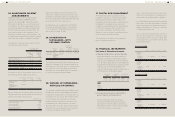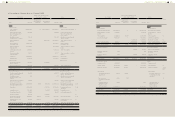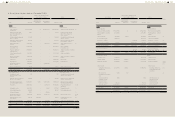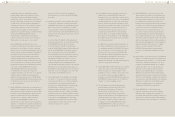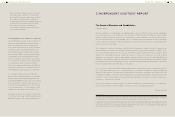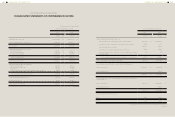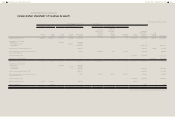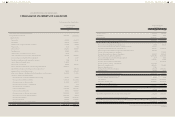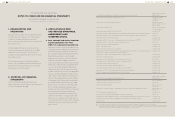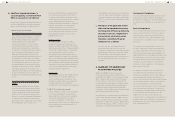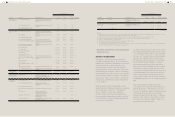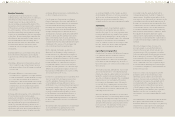HTC 2013 Annual Report Download - page 120
Download and view the complete annual report
Please find page 120 of the 2013 HTC annual report below. You can navigate through the pages in the report by either clicking on the pages listed below, or by using the keyword search tool below to find specific information within the annual report.
FINANCIAL INFORMATION FINANCIAL INFORMATION
236 237
reporting. However, a deferred income tax
assetor liability that is not related to an asset
or liability for financial reporting should be
classified as current or noncurrent on the basis of
the expected length of time before it is realized
or settled. By contrast, under the Regulations,
a deferred income tax asset or liability is always
classified as noncurrent. Thus, as of January
1 and December 31, 2012, the reclassification
adjustment resulted in decreases of NT$1,517,302
thousand and NT$1,948,496 thousand,
respectively, in "deferred income tax asset -
current" and increases by the same amounts in
"deferred income tax assets - non-current."
Under ROC GAAP, deferred tax assets are
recognized in full but are reduced by a valuation
allowance account if there is evidence showing
that a portion of or all the deferred tax assets will
not be realized. However, under the Regulations,
an entity recognizes only to the extent that it
is highly probable that taxable profits will be
available against which the deferred tax assets
can be used; thus, a valuation allowance account
is not used. Thus, as of January 1 and December
31, 2012, the reclassification adjustment resulted
in decreases of NT$10,962,549 thousand
and NT$6,265,293 thousand, respectively,
in "deferred income tax assets" and in the
valuation allowance account. Also, as of January
1 and December 31, 2012, the reclassification
adjustment resulted in increases of NT$187,469
thousand and NT$150,534 thousand, respectively,
in "deferred income tax assets" and "deferred
income tax liabilities".
3) Under ROC GAAP, deferred income tax assets or
liabilities from intergroup sales are recognized for
the change in tax basis using the tax rate of ROC.
However, under the Regulations, the buyer's tax
rates are used instead. Thus, the Regulations
adjustment as of January 1, 2012 resulted in
increases of NT$58,000 thousand each in
"deferred income tax assets" and "accumulated
earnings." In addition, the evaluation adjustment
made on December 31, 2012 resulted in increases
of NT$83,000 thousand in "deferred income
tax assets" and in "accumulated earnings"
and a decrease in "income tax" by NT$25,000
thousand.
4) Under the Regulations, the Company elected to
recognize all cumulative actuarial gains and of
NT$83,687 thousand in "accumulated earnings"
due to decreases in "investments accounted
for using equity method" by NT$593 thousand,
"defined benefit assets" by NT$82,801 thousand
and "net loss not recognized as pension cost" by
NT$293 thousand.
As of December 31, 2012, the IFRS adjustment
resulted in a decrease in "accumulated earnings"
by NT$86,417 thousand due to decreases
in "Investments accounted for using equity
method" by NT$484 thousand, "defined benefit
assets" by NT$86,489 thousand and "net loss
not recognized as pension cost" by NT$347
thousand and increase in "deferred income tax
assets" by NT$903 thousand. In addition, this
adjustment resulted in decreases in "cost of
revenues" by NT$422 thousand, "selling and
marketing expenses" by NT$505 thousand,
"general and administrative expenses" by NT$171
thousand, "research and developing expenses"
by NT$524 thousand and an increase in "share of
the profit or loss of subsidiaries, associates and
joint ventures" by NT$115 thousand.
5) Under ROC GAAP, if an obligation is probable
(i.e., likely to occur) and the amount could be
reasonably estimated, it is a contingent liability
and should be accrued for, but under which
account is not clearly defined. However, under
the Regulations, it defines "provisions" as
obligations that are probable (i.e., more likely
than not) and the amount could be reasonably
estimated. Thus, as of January 1 and December
31, 2012, the reclassification adjustment resulted
in decreases of NT$14,808,145 thousand and
NT$7,603,717 thousand, respectively, in "other
current liabilities" and increases by the same
amounts in "provisions - current."
6) Accumulated compensated absences are not
addressed in existing ROC GAAP; thus, the
Company has not recognized the expected cost
of employee benefits in the form of accumulated
compensated absences at the end of reporting
periods. However, under the Regulations, when
the employees render services that increase their
entitlement to future compensated absences,
an entity should recognize the expected cost
of employee benefits at the end of reporting
periods. Thus, as of January 1, 2012 resulted in
an increase in "accrued expenses" by NT$99,321
thousand and a decrease by thesame amount in
"accumulated earnings".
In addition, the evaluation adjustment made on
December 31, 2012 resulted in (a) a decrease in
"accumulated earnings" by NT$93,451 thousand
due to an increase of "accrued expenses"; (b)
decreases in "cost of revenues" by NT$5,299
thousand and "selling and marketing expenses"
by NT$4,843 thousand and (c) increases in
"general and administrative expenses" by
NT$557 thousand and "research and developing
expenses" by NT$3,715 thousand.
7) Under ROC GAAP, deferred charges are classified
under other assets. Transition to Regulations,
deferred charges are classified under "other
intangible assets" according to the nature. Thus,
as of January 1 and December 31, 2012, the
Company reclassified NT$120,593 thousand and
NT$91,810 thousand, respectively, of "deferred
charges" to "other intangible assets."
8) The Company purchased fixed assets and
made prepayments, pursuant to the "Rules
Governing the Preparation of Financial
Statements by Securities Issuers." Such
prepayments are presented as "properties".
Transition to Regulations, the prepayments are
classified under "other assets - other". Thus,
as of January 1 and December 31, 2012, the
Company reclassified NT$103,745 thousand
and NT$208,750 thousand, respectively, of
"property, plant and equipment" to "other assets
- other."
9) Under ROC GAAP, if an investee issues new
shares and an investor does not purchase new
shares proportionately, capital surplus and the
long-term equity investment accounts should
be adjusted for the change in the investor's
holding percentage and interest in the investee's
net assets. By contrast, under the Regulations,
a reduction of investor's ownership interest
that results in loss of significant influence on
or control over an investee would be treated
as a deemed disposal, with the related gain or
loss recognized in profit or loss. An entity may
elect not to adjust the difference retrospectively,
and the Companyelected to use the exemption
from retrospective application. The Regulations
adjustment resulted in a decrease of capital
surplus - long-term equity investments of
NT$18,037 thousand and a corresponding
increase of accumulated earnings by related
rules.
10) The Company elected to reset the accumulated
balances of exchange differences resulting from
translating foreign operation to zero at the date
of transition, and the reversal has been used
to adjust accumulated earnings as of January
1, 2012. The gain or loss on any subsequent
disposals of any foreign operations should
exclude accumulated balances of exchange
differences resulting from translating foreign
operation that arose before the date of transition.
Therefore, the Regulations adjustment resulted in
a decrease in accumulated balances of exchange
differences resulting from translating foreign
operation and an increase in accumulated
earnings by NT$32,134 thousand each.
11) Under ROC GAAP, for the downstream
transactions between an investor company
and an investee company, the elimination of
unrealized gains from intercompany transactions
was shown as a deferred credit under liabilities.
Under Regulations, the elimination of unrealized




